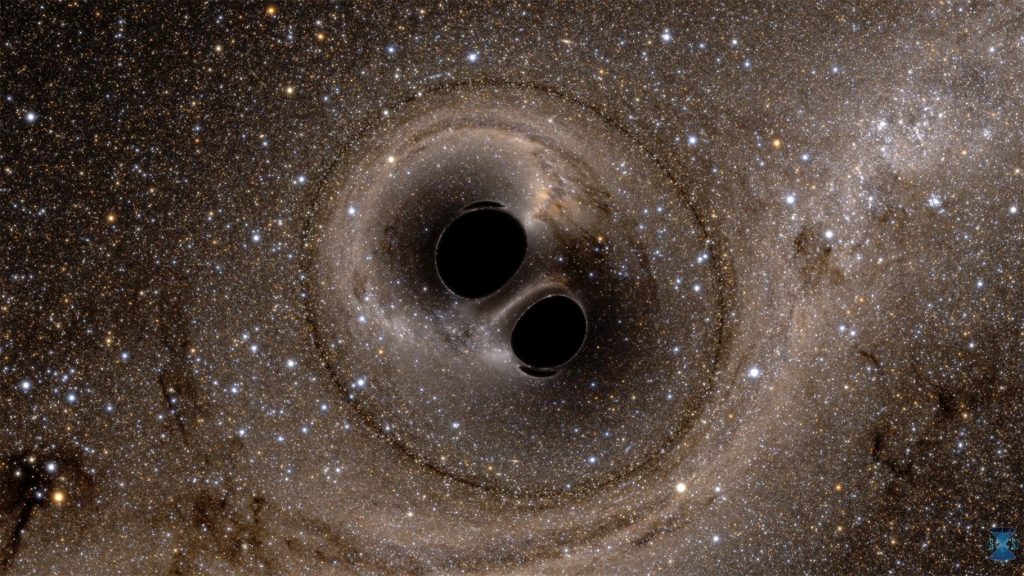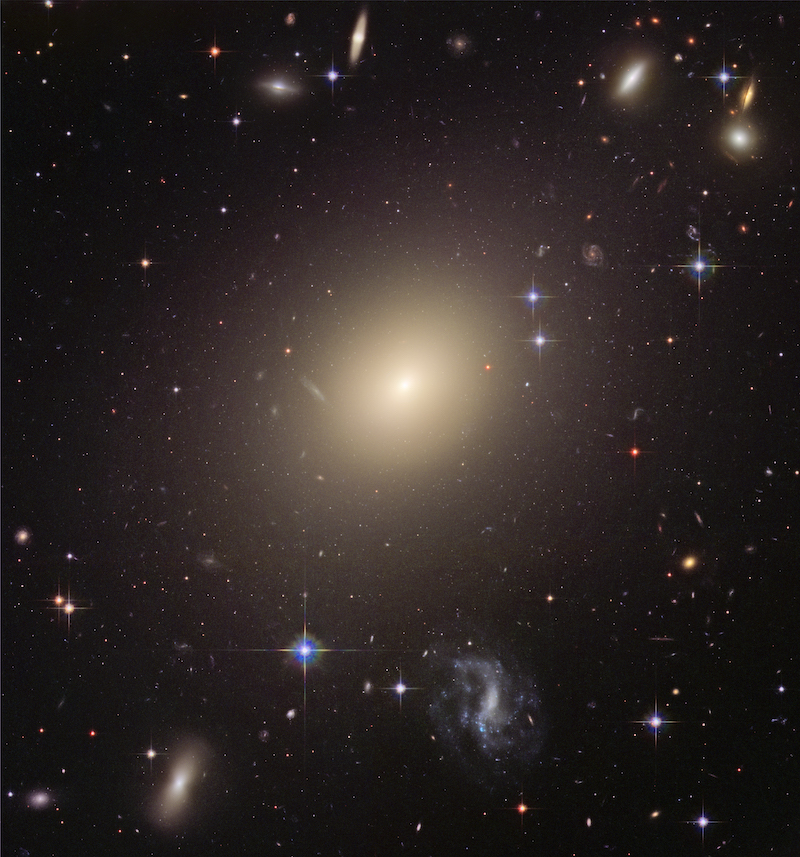Two new studies are attempting to solve a couple of big puzzles in astrophysics: Is the Hubble constant actually constant? And why do galaxies have flat rotation curves? Plus, a young star’s circumstellar disk, the search for stellar-mass black holes, magnesium in the deep waters of Neptune and Uranus, and an interview with PSI scientist David Horvath regarding possibly active volcanism on Mars.
Media
Transcript
Hello and welcome to the Daily Space. I am your host, Beth Johnson.
Pamela is off today, so I will be here solo to put science in your brain.
Later in today’s episode, I’m going to be joined by PSI’s own David Horvath to discuss volcanism on Mars. Before we get to that, however, we have a lot of weird science to cover.
Geologists and planetary scientists do a lot of different things to try to understand all the processes that shape our planet and others. From sending spacecraft to the far corners of the solar system, to digging through the minerals of our planet, you never know where they will find the latest breakthroughs. And it turns out some of the most interesting results come from laboratory experiments designed to recreate the conditions of other worlds.

In a new experiment published in Nature Astronomy and led by Tawhyun Kim, researchers studied what happens at the boundary between an ice giant’s high-pressure water layer and deeper rock layer. Ice giants like Uranus and Neptune are the most commonly discovered planets in our galaxy, and they have, for a planet, fairly straightforward structures that include an outer gas layer, ice or fluid, a rocky mantle, and then a metallic core.
To replicate the water-rock boundary, the researchers combined rocks – olivine and ferropericlase – and water and then compressed the sample with a diamond anvil. The temperatures and pressures allowed the water to draw magnesium out of the rocks in large amounts and indicate that fluid layers in ice giants may be rich in magnesium. This is important because magnesium-rich water is a good thermal insulator.
This may explain how Uranus, which is closer to the Sun than Neptune, is the cooler of the two worlds. According to study coauthor Sang-Heon Dan Shim, “This magnesium-rich water may act like a thermal blanket for the interior of the planet,” allowing it to block heat from escaping the interior of the planet. Here is to hoping we see more and more awesome lab science results as universities begin to reopen their facilities.
As much as we love lab science, there really isn’t anything like getting out there and exploring the sky with telescopes. The only problem is, for most things in the universe, we only get one viewing angle, and that is the random one we have from here on the surface of the Earth. This puts where we are at the whim of the universe, and while we find plenty of stuff aligned at angles varying from edge-on to face-forward, just like photographers inching around our subject, for some science we want a very specific, viewing angle, and finding that angle requires a bit of luck, which scientists observing the still-forming star GV Tau N just happened to have. This star is still accreting matter from a large disk of gas and dust that surrounds it.

From our vantage point on Earth, this system is ever so slightly tilted, and this tilt allows us to see straight along the edge of that wedge-shaped disk to the star in its center. Using the TEXES spectrograph on the Gemini North telescope in Hawaii, the team measured the flow of material along the wedge and discovered rapidly inflowing gas in the amounts predicted by star formation theories! Specifically, they found a few Earth masses of material flowing in per year. This is one of those rare and glorious instances when we can say the observations matched what we expected from theory, and it looks like we understand one beautiful part of star formation.
One of the problems with trying to sort reality from theory is that mathematically a lot of things are possible that aren’t actually real. For instance, we could turn the Earth into a black hole that could politely sit in the palm of your hand, at least for a moment, before it completely consumed you with its gravity. The issue is that there aren’t any situations in which the Earth is going to find itself suddenly compressed. Even if some advanced alien civilization did exist with the desire to compress the Earth into a black hole, they wouldn’t because the required energy is just… a lot.
Basically, black holes could exist of absolutely any size. All that is required is for something to get compressed down so tiny that the escape velocity for that something – the speed that you have to go to escape its gravity – that speed just has to equal the speed of light, and boom – a black hole. With sufficient energy, anyone out there could be turned into a black hole. You wouldn’t survive the process, but, the math says it can happen.

When astronomers go looking for black holes, what we find is objects with masses between roughly 50-120 solar masses just aren’t out there. This is because the most massive stars don’t form black holes when they die; they simply explode themselves completely apart and leave behind an empty supernova remnant. We see black holes from around three solar masses and up, but there is a naturally occurring gap starting around fifty solar masses.
The gap could have another edge if black holes form during the death of even larger objects that are too heavy to blow themselves apart. These objects… we’re still looking for them, but in a new paper in The Astrophysical Journal Letters by Jose María Ezquiaga and Daniel E. Holz, we learn that if they exist (and we have no idea if stars survive with enough mass to form them) they could be detected during the next LIGO / Virgo run as the most massive black hole binaries merging. They can also potentially be seen in the future LISA mission.
Maybe. But it is neat to think stars could form black holes with this weird distribution that starts around three Solar Masses, builds up to fifty solar masses, and then just skips ahead to 120 solar masses. We don’t know if it’s real, but it’s a neat idea worth thinking about.
There are actually a lot of really cool theories out there involving black holes, gravity, the expansion of the universe, and other really awesome ideas that make me glad that I studied planetary science because some of those ideas seem designed to trigger a migraine.
Gravity, for instance, every time we think we finally understand it, someone comes along and throws out an idea that just might be a better match to reality than we have right now. It all started with Newton. He watched that mythical apple fall, looked to the Moon, and realized it’s also falling but just missing the Earth, and a whole lot of math later, including the development of calculus, he had nice sets of equations that allowed accurate predictions of both how objects would fall on Earth and how planets should orbit the Sun.
And, for the most part, those equations matched reality. But there was a problem: Mercury. Mercury’s orbit was a few seconds off, and as the years went by and technology got better, it became impossible to ignore that Mercury just didn’t quite match. This discrepancy was finally explained away when Einstein’s theories of relativity clarified that time and space twist to force the speed of light to always appear the same. Explaining Mercury was just one of the myriad observational pieces of evidence we have saying that relativity works.

But, and there is always that but, Newton’s theories work at lower speeds and in lower gravity environments than what Mercury experiences. Einstein’s theories also have their breaking point; specifically, they don’t work at quantum scales, and everything breaks down inside a black hole. This means we still have more to learn.
When Vera Rubin discovered in the middle of the last century that the outer parts of our galaxy just don’t orbit at the expected velocities, folks looked at two different explanations. The one that would go on to be most accepted is the idea of dark matter. We can explain galaxy rotations, the orbits of galaxies in clusters, and the bending of light as it travels through space by saying there is an unobserved kind of matter that we named dark matter. Literally, we explain the odd variations in orbits by adding invisible stuff to the universe.
But dark matter wasn’t the only theory. Many researchers have also chased additional terms to add to gravity, factors that only kick in at huge distances. Called Modified Newtonian Dynamics or MOND, these theories can be made to work in all manner of situations without requiring invisible matter.
For the most part, people stopped studying MOND when it became possible to measure the distribution of invisible matter by its gravitational pull on light. But some folks kept on working on MOND, and in a new paper in The Astrophysical Journal Letters, researchers led by Kyu-Hyun Chae propose a new version of MOND that is able to explain in a consistent way both the observed motions in spiral and elliptical galaxies. This is important because these two kinds of systems have very different gravitational fields to go with their very different shapes.
If this team is right, or at least on the right path, it could indicate that the universe has once again decided to follow the rules of improv and say “Yes, and”. It could be that there is both an additional term to gravity and there is weird, pretty hard to detect stuff out there which we will call dark matter. It’s possible, maybe, that both are true.
Now, to be clear, we can explain everything we see today with just dark matter. We don’t require modified gravity to solve rotation curves; we just know gravity is missing something, and this is an interesting road to follow just in case it does allow us to find those missing pieces.
Interview
Joining me now is Dr. David Horvath, a research scientist at the Planetary Science Institute whose most recent work has set the science community and internet a flutter. He has published the results of research, performed as a postdoc at the University of Arizona, that provides evidence that Mars is still volcanically active, at least as of 50,000 years ago. Articles on this announcement have appeared everywhere, from CNN to Popular Science to even ComicBook.com.
Thank you for joining us, Dr. Horvath, and welcome.
[Interview]
For now, though, this has been the Daily Space.
Learn More
Lab Finds Magnesium Dissolves Into Water in Neptune-like Conditions
- ASU press release
- “Atomic-scale mixing between MgO and H2O in the deep interiors of water-rich planets,” Taehyun Kim et al., 2021 May 17, Nature Astronomy
Chance Viewing Angle Reveals Stars Birth
- Accretion in Action in an Angled Disk (AAS Nova)
- “High-resolution Mid-infrared Spectroscopy of GV Tau N: Surface Accretion and Detection of NH3 in a Young Protoplanetary Disk,” Joan R. Najita et al., 2021 February 22, The Astrophysical Journal
Black Holes Avoid Forming in Certain Sizes
- Jumping the Gap to Probe Large Black Holes (AAS Nova)
- “Jumping the Gap: Searching for LIGO’s Biggest Black Holes,” Jose María Ezquiaga and Daniel E. Holz, 2021 March 15, The Astrophysical Journal Letters
What Even is Gravity? Seriously, Are We Missing Something?
- Searching for Universal Acceleration (AAS Nova)
- “On the Presence of a Universal Acceleration Scale in Elliptical Galaxies,” Kyu-Hyun Chae, Mariangela Bernardi, Helena Domínguez Sánchez, and Ravi K. Sheth, 2020 November 6, The Astrophysical Journal Letters
Credits
Written by Pamela Gay and Beth Johnson
Hosted by Pamela Gay and Beth Johnson
Audio and Video Editing by Ally Pelphrey
Content Editing by Beth Johnson
Intro and Outro music by Kevin MacLeod, https://incompetech.com/music/


 We record most shows live, on Twitch. Follow us today to get alerts when we go live.
We record most shows live, on Twitch. Follow us today to get alerts when we go live.